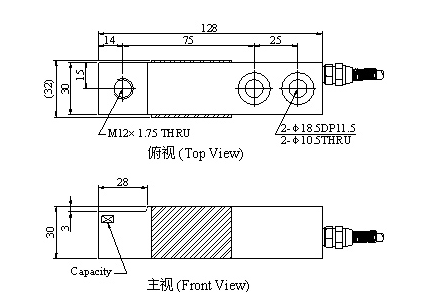【
Guangzhou Zhongxin Automation Technology Co., Ltd】Professional supply
Taiwan Mavin weighing sensorNB1 sensor NB1-100kg~NB1-1t_ Taiwan's Mavin weighing sensor ensures fast delivery, 100% genuine, and strives to become the top brand for sensor sales in China. Taiwan's mavin NB1 series weighing sensor models: NB1-100kg, NB1-150kg, NB1-200kg, NB1-300kg, NB1-500kg, NB1-750kg, NB1-1000kg
NB1 Series Sensor Product Introduction
Product brand: Taiwan Mavin
Product series: NB1
Product Type:
Cantilever beam type weighing sensorHigh precision, good stability, and easy installation
Application field: hopper scale, platform scale
Range can be selected: 1001502003005007501000 (kg)
Appearance dimensions of NB1 series sensors
 NB1 series sensor technical data
NB1 series sensor technical data
| Rated load |
100,150,200,300,500,750,1000 (kg) |
| Rated output |
2.0 mV/V±0.25% |
| Nonlinear |
0.03 %R.O. |
| lagging |
0.03 %R.O. |
| Repeatability |
0.03 %R.O. |
| Creep/return to zero (30 minutes) |
0.03 %R.O. |
| Output temperature influence |
0.002 %R.O./℃ |
| Zero temperature effect |
0.003 %R.O./℃ |
| Zero balance |
±0.0200 mV/V |
| Input impedance |
410 ± 15 Ω; |
| Output impedance |
350 ± 5 Ω; |
| Insulation impedance |
≥5000 MΩ/(50VDC) |
| Safety overload rate |
150 %R.O. |
| Ultimate overload rate |
200 %R.O. |
| Operating temperature range |
-20~60 ℃ |
| Recommended operating voltage |
5~12 VDC |
| Maximum working voltage |
15 VDC |
| material quality |
aluminium alloy |
| Protection level |
IP67/ IP68 |
| cable |
Φ6×2 m |
| Wiring method |
Red: power supply+, black: power supply -, green: signal+, white: signal- |
Complete model of NB1 series sensor
NB1-100kg,NB1-150kg,NB1-200kg,NB1-300kg,NB1-500kg,NB1-750kg,NB1-1000kg
Extended Reading
Inspection method for pressure sensors:
The production of pressure sensors generally requires systematic testing; After purchasing the pressure sensor, we can perform general routine testing on the pressure sensor and use a multimeter for simple testing. How to use a multimeter for simple testing?
The use of a multimeter to detect pressure sensors can only be used for simple testing, and the test results are only for reference. Multimeter testing can be divided into the following three methods:
Pressure detection: Supply power to the sensor, blow the air guide hole of the pressure sensor with a nozzle, and use the voltage range of a multimeter to detect the voltage change at the output end of the sensor. If the relative sensitivity of the pressure sensor is large, this change will be significant. If there is no change at all, it is necessary to use a pneumatic source to apply pressure.
Bridge circuit detection: mainly detects whether the circuit of the sensor is correct, usually a Wheatstone full bridge circuit, using the ohm range of a multimeter to measure the impedance between the input terminals and the impedance between the output terminals. These two impedances are the input and output impedances of the pressure sensor. If the impedance is infinite and the bridge circuit is disconnected, it indicates that there is a problem with the sensor or the definition of the pin is not correctly determined;
Zero point detection: Use the voltage range of a multimeter to detect the zero point output of the sensor without applying pressure. This output is usually a voltage of mV level. If it exceeds the technical specifications of the sensor, it indicates that the zero deviation of the sensor is out of range;
By using the above three methods, the approximate condition of the pressure sensor can be detected. If precise detection is required, a standard pressure source needs to be used to apply pressure to the sensor, and the sensor needs to be calibrated according to the magnitude of the pressure and the variation of the output signal. And if conditions permit, conduct temperature detection of relevant parameters. In short, the detection of pressure sensors is a responsible task, and a multimeter can perform general testing, which can be applied in many cases. However, if pressure sensors are required to be used in strict environments, systematic testing is necessary.
Performance indicators of weighing sensors
The performance of a weighing system can be measured by indicators such as linearity, hysteresis, repeatability, and creep.
Linearity: Indicates the degree of consistency between the actual output of the system and the theoretical straight line. As shown in the figure, when linear errors occur, the output of the system is correct at no load and full load, but the input-output points between these two points are inconsistent with the ideal state. Linear error is the maximum difference between the theoretical straight line and the actual output curve.
Lag: Refers to the degree to which the input-output curve of the system does not coincide during loading and unloading processes.
Repeatability: Refers to the degree of inconsistency in the system's output for several consecutive weighing of the same weight during the loading or unloading process. Usually expressed as the percentage of the total output that is the difference between the minimum output and the maximum output of the system under the same loading condition.
Creep: Refers to the characteristic of a system bearing a constant weight at a certain temperature, and the output changes over time due to mechanical deformation of the elastic material of the sensor.
The above are [NB1 sensor] NB1-100kg~NB1-1t_ Detailed information of Taiwan Mavin weighing sensor, if you are interested in [NB1 sensor] NB1-100kg~NB1-1t_ If you have any questions about the price, delivery time, model, or inventory of Taiwan Mavin weighing sensors, please feel free to call
18520271262Obtain 【 NB1 Sensor 】 NB1-100kg~NB1-1t_ Taiwan Mavin
Load CellLatest price details for.

